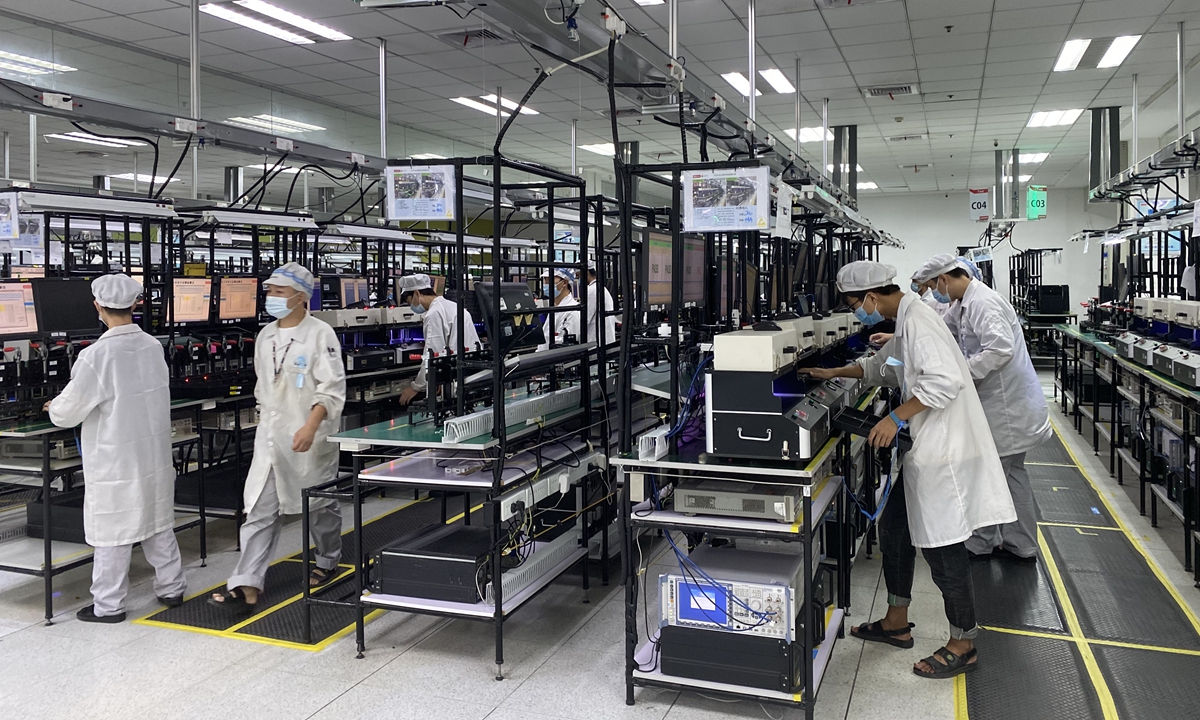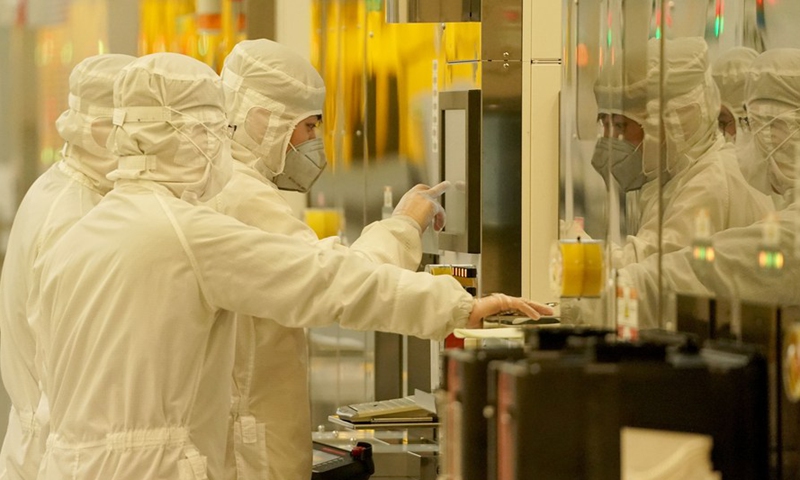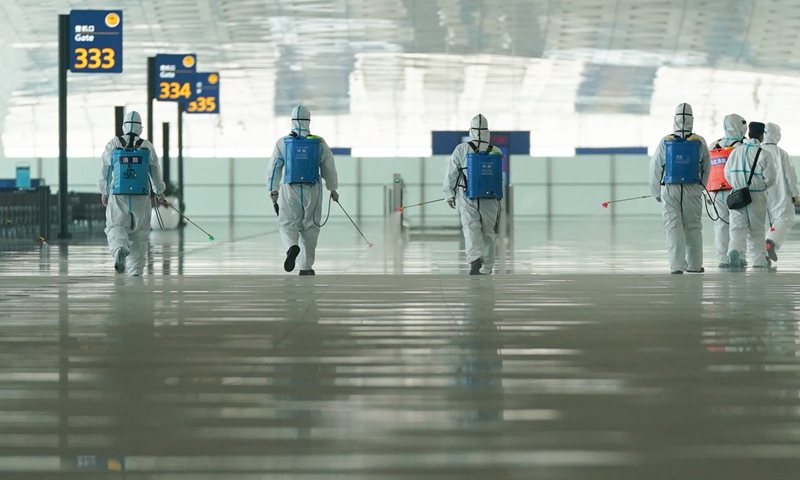


Photo: Shen Weiduo/GT
Wearing masks, eating separately, having their body temperatures checked, frequently using disinfectant, more than 10,000 employees are working hard in the Lenovo factory, where notices that "epidemic control is our responsibility" are posted all over. The Lenovo factory is located in Wuhan, capital of Central China's Hubei Province, the hardest-hit city during the early COVID-19 outbreak in the country.
Nevertheless, work is back to normal, as staff assemble a mobile phone or tablet through the production line every second. More than 100,000 mobile phones are produced in the factory every day, and then shipped all over the country and the world from Wuhan - the city that emerged from a 76-day lockdown during the COVID-19 epidemic
Last week, workers witnessed a new 5G foldable phone, Lenovo's Motorola 5G Razr, assembled and tested in Wuhan, ready to be shipped to more than 160 countries and regions around the world, marking another milestone for the Chinese tech firm. It a reminder to the rest of the world that the city has not only restored full production capacity, but is also marching forward at a faster-than-expected speed.
In the second quarter of the year, the Wuhan East Lake High-Tech Development Zone, known as the "Optics Valley of China" and home to many big names including Foxconn, Lenovo, and China Star Optoelectronics Technology Co, has achieved a GDP growth of 13.5 percent year-on-year despite the virus onslaught.
Since resuming production in April, increasing investment from both home and abroad, and top-down support from the whole country, has empowered Wuhan to restore its manufacturing capability and recover rapidly from the epidemic.

Technicians work in a workshop of Wuhan Xinxin Semiconductor Manufacturing Co., Ltd (XMC) in Wuhan Donghu New Technological Development Zone in Wuhan, capital of central China's Hubei Province, Feb 14, 2020.Photo:Xinhua
In March, US-based manufacturing giant Honeywell registered a wholly owned subsidiary, the Huosheng Industrial Technology Co in Wuhan as its headquarters for the company's mass-mid segment business in China. In early June, the first 200 employees of Chinese smartphone maker Xiaomi officially moved into its Wuhan headquarters. And on June 20, Mindray Medical International Co, the country's largest medical manufacturer, invested 4.5 billion yuan ($658.43 million) in constructing a base in Wuhan, its second global base worldwide.
"A few months ago, Wuhan was the center of the epidemic storm, but now it has become the weather vane of China's post-epidemic economic development," Yang Yuanqing, chairman and CEO of Lenovo, said in Wuhan on Thursday.
According to local newspaper the Changjiang Daily, Wuhan's economy in the second quarter has bounced back to the same level in the same period last year, a huge reversal from the first quarter, when its GDP declined 40.5 percent year-on-year.
Flights through Wuhan's Tianhe International Airport had reached 500 on Friday and passenger volume in the airport reached 64,700 on the same day, equal to the same level last year, the Xinhua News Agency reported Sunday.
The city also launched a project on Saturday to build a pavilion with the world's largest indoor exhibition area - 450,000 square meters, local media reported.
"Data can show only part of the story, as when you look back, only people who've gone through it can know how hard it was, and truly understand the resilience and flexibility of China's industrial chain," a production manager at an electronics firm in Wuhan surnamed Zhang told the Global Times on Friday.

Firefighters conduct disinfection at the Wuhan Tianhe International Airport in Wuhan, central China's Hubei Province, April 3, 2020. Photo:Xinhua
The city was cut off from the rest of China and the world after the entire city of 11 million people was placed under lockdown, a move that was unprecedented but also necessary at the time. All work was halted, all transportation stopped and almost everyone was grounded at home, all in an effort to curb the virus.
"The pandemic also made it clear - halting production in Wuhan also means halting the global industrial chain," said Zhang, adding that his firm is still catching up with all the orders from customers - including Foxconn, a key supplier of Apple - that were left behind during the lockdown.
"Many key materials are produced and shipped out of Wuhan to other bases in Brazil and Argentina, thus after the city was 'closed' on January 23, our overseas factories were also greatly impacted," Chen Shuli, a senior executive of Lenovo Group told the Global Times.
"We talked with several factories in South China's Guangdong Province, organized the workers to remain in the city, moved and packed all we could move along the supply chains from Wuhan to Guangdong, and asked workers outside the city who cannot come back to Wuhan to go to factories in Guangdong - that's how we managed to keep our global supply chain running and global shipments during the most difficult time," Chen said.
Starting from mid-March, when pandemic situation saw signs of easing, with the help of local authorities, Lenovo's Wuhan factory sent 400 vehicles to bring 7,000 employees back to the base, and "restart" the base. Full production was restored on April 7.
"Since April, our tablet production has been in full swing and even achieved a rapid growth rate of about 65 percent to 68 percent year-on-year, Chen said.
The full production resumption for Zhang's firm though came later in May, its production also achieved an increase of 40 percent over the past three months compared with the same time last year.
To supply the world
For most manufacturers in the city, and those across the whole country, restoring production is no longer a problem, as how to supply world demand while the pandemic still casts its shadow on some countries and regions is a new priority.
BGI Group, a world-leading Chinese genome research organization, is a firm that never stopped running during the epidemic and is now busy as usual, while shifting its focus from only supplying Wuhan to the whole country, and now to the whole world.

Members of staff work at a COVID-19 testing lab built with an air-inflated structure in Daxing District, Beijing, capital of China, June 22, 2020. File photo:Xinhua
"We built a coronavirus lab that can do 10,000 tests in January in just five days - normally, it would take three months," Zhu Shida, BGI's "frontline general commander" in Wuhan, said on Thursday, adding that working 24 hours a day was normal when the epidemic was most severe.
BGI's Wuhan testing lab, named Huoyan, has tested more than 700,000 people in the Hubei Province. So far, the coronavirus test kits produced in Wuhan have been sent to more than 80 countries and regions, and the whole technology solution and lab model have been replicated and expanded to the world to fight the pandemic, BGI told the Global Times.
China saw sustained and stable improvement in its foreign trade in August, with exports maintaining a strong growth rate of 11.6 percent year-on-year, while total exports have edged back to growth in the first eight months this year - from January to August, China's exports were up by 0.8 percent year-on-year.
"We are still encountering difficulties every day - we are still fighting a lack of some key materials as the global pandemic situation has not eased yet," Wan Heng, general manager of Wuhan Hengtong Technology Co, told the Global Times on Friday.
"And we are also striving to increase automation rate of our production line and further increase production during the past months, and encourage our upstream and downstream manufacturers to come closer, and meet demand," said Wan.

 Award-winning photos show poverty reduction achievements in NE China's Jilin province
Award-winning photos show poverty reduction achievements in NE China's Jilin province People dance to greet advent of New Year in Ameiqituo Town, Guizhou
People dance to greet advent of New Year in Ameiqituo Town, Guizhou Fire brigade in Shanghai holds group wedding
Fire brigade in Shanghai holds group wedding Tourists enjoy ice sculptures in Datan Town, north China
Tourists enjoy ice sculptures in Datan Town, north China Sunset scenery of Dayan Pagoda in Xi'an
Sunset scenery of Dayan Pagoda in Xi'an Tourists have fun at scenic spot in Nanlong Town, NW China
Tourists have fun at scenic spot in Nanlong Town, NW China Harbin attracts tourists by making best use of ice in winter
Harbin attracts tourists by making best use of ice in winter In pics: FIS Alpine Ski Women's World Cup Slalom
In pics: FIS Alpine Ski Women's World Cup Slalom Black-necked cranes rest at reservoir in Lhunzhub County, Lhasa
Black-necked cranes rest at reservoir in Lhunzhub County, Lhasa China's FAST telescope will be available to foreign scientists in April
China's FAST telescope will be available to foreign scientists in April